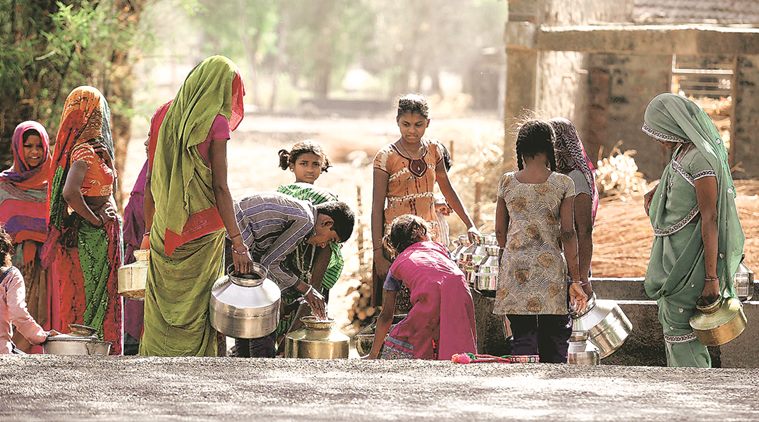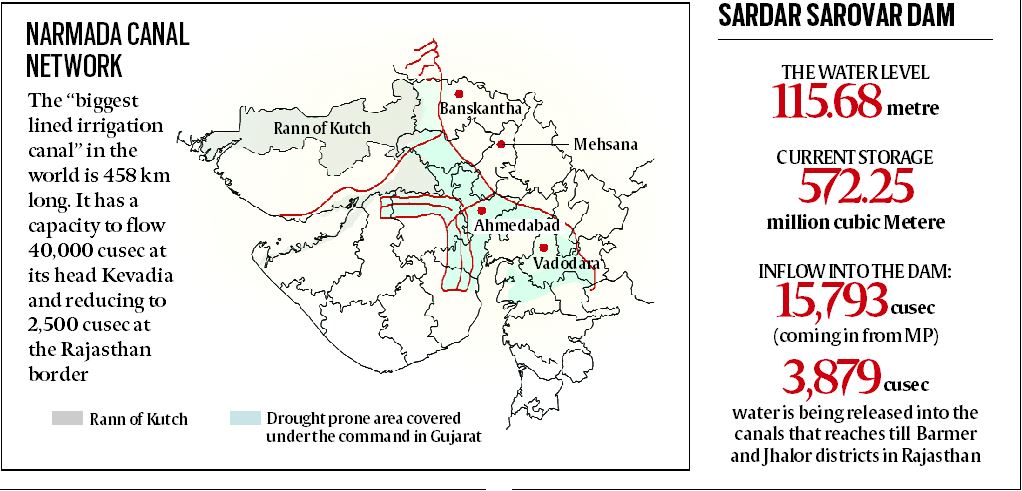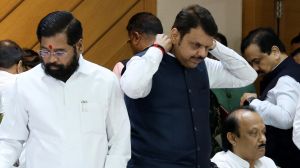Stay updated with the latest - Click here to follow us on Instagram
Hardlook: Thirsty Gujarat cities… fed by Narmada
At a time when several parts of the country are facing acute water crisis, most civic bodies in Gujarat have maintained regular supply of water — thanks to Narmada.
 Dungar village in Vadodara district faces severe water crisis after wells dried up, but in the city the condition is better as three lines at Nimeta pump have ensured “equal” distribution of water.
Dungar village in Vadodara district faces severe water crisis after wells dried up, but in the city the condition is better as three lines at Nimeta pump have ensured “equal” distribution of water.
About 30 km from Ahmedabad, the country’s first ‘smart city’ — Gujarat International Finance Tec-City (GIFT) — is being built. Located on the banks of Sabarmati, it is going to be served Narmada water, treated enough to be potable, straight from the tap.
If the availability of potable water has not been critical in major cities of Gujarat at the peak of summer, even as large parts of the country go thirsty, it is because of river Narmada, which feeds to a number of urban centres, including state capital Gandhinagar. Soon, its water will be taken to as far as Junagadh.

GANDHINAGAR
Water supply to Gandhinagar city has remained with the Roads & Buildings (R&B) Department of the Gujarat government even after the capital was conferred the status of municipal corporation in 2011 following a Gujarat High Court order. Narmada is the main source of water to the city since 2001 after Sabarmati, which runs through it, dried up in 1999.
The first planned city in Gujarat, Gandhinagar with a population of around two lakh has 30 sectors, which have divided into two parts by the Capital Project Circle (CPC) of the R&B Department. Executive Engineer of CPC Bharat Pandya says that from Sector 1 to Sector 14, water is being provided from Sarita Udyan Headworks. Whereas, Sector 15 to Sector 30 get water from the CPC’s Charedi Headworks.
According to Pandya, there are around 40 borewells in the city, but used mainly to maintain pressure in the supply lines.
Assistant Engineer of the CPC Kalpesh Shah says, “The city has a total water requirement of around 55 millions of litres per day (MLD).
And, almost all of that is being fulfilled by Narmada water from the main canal of the Narmada Project.”
Another Assistant Engineer of the CPC, Jignesh Patel, says the CPC gets water from the Gujarat Water Supply & Sewerage Board (GWSSB), which provides it from the Narmada main canal. The CPC gets water at the two headworks from where it is supplied to around 47,000 individual households, government buildings, government colonies and non-residential units for two-and-a-half hours everyday in the morning.
“Till 1999, Gandhinagar city used to get water from Sabarmati through radial wells prepared in the riverbed. However in 1999, the river dried up in the city following which water was being supplied through 40 borewells which were prepared on urgent basis,” says Patel. “Later from 2001, Gandhinagar is getting Narmada water. There is no water shortage in the city since then,” he adds.
Jankiben Thakkar, a homemaker in her 30s and resident of Vasna for seven years, does not know the source of drinking water supplied to her house. Another resident from the same area, Kalyani Shukla, a homemaker in her 40s, also has no clue that the water she drinks comes from Narmada. “The Ahmedabad Municipal Corporation supplies water everyday. Earlier, however, it was for three hours, and now it has been reduced by one hour.” When asked about her experience since the city was connected to Narmada canal, she says, “I don’t know where the water is sourced from, so how can I tell the difference. This house is getting water for the last 40 years from the AMC only.”
In 2006, a pipeline connected Narmada to Ahmedabad residents.
Hardikbhai Mamtora, a businessman residing in Ambawadi area for 20 years shared a similar feedback. “We have no problem in the AMC water supply, but I cannot tell you whether we are getting the Narmada water or not. It’s the same in all these years.”
Misbah Ibrahim, a pentaganerian grandmother of two staying in Paldi area, did not recall if they have paid additional surcharge for Narmada water pipeline. “We haven’t paid any additional amount before or after 2006. We have been paying approximately the same charges for water since the time we have been living here.”
The AMC meets more than 90 per cent of water requirement through Narmada. AMC officials, who ensure that residents of the city get two hours of water supply (between 6 am and 8 am, rule out any possible shortage of water in the city which has over 11.57 lakh water connections, including 11,11,717 residential, 33,352 commercial and 2,039 public tap water connections.
The city’s estimated water supply is nearly 1125-1135 MLD. Nearly 200 MLD is met through Raska weir that gets water from Mahi river in Vasad near Vadodara. Apart from this, the city gets nearly 15 per cent i.e. 315 MLD water supply from borewells and another 200 MLD from two intake wells — at Dudheshwar and Kotarpur.
“At present, there is no water shortage for city’s consumption. Since, our chief source is Narmada river, no water crisis expected even in the summer. We just have to ensure proper maintenance on day-to-day basis so that our daily requirements are met without any disruption,” said Jagdish Patel, AMC’s special city engineer.
To check water leakage and wastage, the AMC authorities claimed the civic body is in the process of installing flow metres. However, as per the claims made by opposition Congress claims over 260 MLD of water supply is wasted every day.
(Inputs from Taranna Emmanuel)
VADODARA
Amrut Makwana, Executive Engineer of Water Supply, Vadodara Municipal Corporation, is confident that the city will not have drinking water scarcity till July 13, even if the monsoon is delayed.
Kinjal Patel, a resident of Gorwa in Vadodara, says, “We have daily water supply, and face cuts only when the civic body announces repair of the Frenchwell. Though there are no pronounced water cuts during the summer, we can make out from the pressure of the water that the VMC is supplying less water as the water tanks do not fill to the brim these days. We have been hearing about additional water supply since the last few years, but it does not seem that the VMC has any plan for that.”
According to VMC officials, the recent activity of interconnecting the three water lines at Nimeta pump have ensured “equal” distribution to all parts of the city, even in case of a fault in any one line. VMC officials said that Ajwa reservoir — that provides water to the city — is at 209.75 feet. The city receives 145 MLD water in three connections — east, south and west. In addition, the city receives 60-70 MLD water from Khanpur water filtration plant that draws water from the Narmada canal as well as 260-270 MLD water from Mahi.
The VMC had been under attack for under utilizing the 75 MLD capacity Khanpur plant due to lack of agreement with the Sardar Sarovar Narmada Nigam Limited (SSNNL). The corporation, now, says it formalised the agreement with the SNNL in July last year, after the plant was inaugurated in 2013 without any agreement. The agreement lays down conditions for the water supply from the Narmada canal and directs the VMC to alter the height of the intact structure of the plant as well as build a reservoir to avoid supply problems during maintenance activity under taken by the SSNNL on the canal. “The interconnection of the three lines at Nimeta has helped make the distribution of water even across the city. We are keeping a close watch on illegal motor pumps and taking action against such pilferage,” says Makwana.
RAJKOT
Pradeep Trivedi, consulting civil engineer who lives in Chitralekha Apartment on the posh 150 Ring Road of the city, says Narmada supply has increased the overall water availability in Rajkot, but increase population of the city has offset the increment of potable water. “Every year, we have to purchase water from private suppliers during summer. The supply from the civic body is never enough. A tubewell makes up for the shortfall during monsoon and winter, but it goes dry during the summer,” says Trivedi, who is living in the apartment for 12 years, about time the city started getting Narmada water.
“Earlier, I used to live near Amrapali cinema, and water issues were more manageable then, since we would know as to how much water we would get every day and the user was my family only. But here, we share the water with 37 other families,” the engineer adds. The building has underground storage tank and overhead tanks. It also has a system in place to harvest rain water.
Thanks to Narmada, the city was able to tide over severe water crisis in the summers of 2011-12 and 2012-13, even though cuts were imposed then. The Rajkot Municipal Corporation (RMC) has maintained supply for 20 minutes every day since then.
Local source Aji went dry in December. Nyari dam, another local source, dried up this month. Therefore, the city of 15 lakh population is dependent on 40 MLD from Bhadar dam, and 210 MLD from Narmada.
Water Supply Minister Vijay Rupani, who is an MLA form the city, has repeatedly assured that no cuts will be imposed. However, disruption in Narmada supply led to erratic distribution in some parts early April.
The Jamnagar Municipal Corporation imposed a water cut early in April by reducing supply to 12 days a month from the previous 15 days a month. This means, 7.5 lakh residents of the city are not getting water for two consecutive days once every week. Civic officers say the cut was warranted as Sasoi, Ranjitsagar and Und dams, the local sources, have run dry and supply from Aji-III dam is meagre.
“We supply around 95 MLD water. Out of that, 75 MLD is from Narmada project, and the rest 20 from Aji-III. In such a scenario, any disruption in Narmada supply leads to a crisis. To tide over such a crisis, we have imposed additional cut,” says Dinesh Chhatrala, Executive Engineer with water works department of the JMC.
The civic body supplies water for 45 minutes and distribution comes to around 115 litre per capita, civic officers say. The JMC has also installed 111 temporary water tanks, each having a capacity of 5,000 litre, and water tankers make 150 trips every day to fill them up.
Similarly, Porbandar and Chhaya municipalities also imposed a water cut by supplying water once in three days in early April. The previous schedule was every alternate day. “We supply around 14 MLD water in Porbandar every day. Majority of it comes from Narmada as local sources Khambhala and Fodala dams ran dry a month ago. We are lifting dead water from these dams to meet emergency situation. We have been alloted 17 MLD of Narmada water but actually, we get around 13 MLD. Faults in Narmada supply lines can make situation worse. To factor in such a situation, the cut has been imposed,” says Rudresh Hudad, chief officer of Porbandar municipality.
In Junagadh, the municipal corporation has reduced the duration of supply from the previous 45 minutes to 30 minutes around the same time. “Anandpur and Willingdon dams have water which will last till May-end while there is enough buffer in Hasnapur dam to see us through to the next monsoon. We are likely to start getting 15 MLD Narmada water from June. But to take care of any supply disruption, we reduced the distribution period to 30 minutes every alternate day from the previous 45 minutes,” says a top officer in the water works department Junagadh Municipal Corporation.
Junagadh has a population of around 4.5 lakh and the civic body supplies 21 MLD water. The JMC has also installed 250 temporary water tanks in areas where there is no distribution network.
Bhavnagar has also not imposed any new water cuts, and the city gets around 40 MLD of Narmada water out of its total supply of 120 MLD. Khodiyar dam which supplies one MLD water hit rock-bottom in February, but Shetrunji and Gaurishankar Lake have enough water. The Bhavnagar Municipal Corporation (BMC) is drawing average 72 MLD and 16 MLD, respectively, from these two dams. “We can draw additional water from Shetrunji but it is almost as costly as Narmada water. We pay Rs 6 per 1,000 litre of Narmada water. The cost of Shetrunji water comes to around Rs 4.50 per 100 litre,” says Chandrakant Devmurari, Executive Engineer in water works department of the BMC. Residents in Bhavnagar get water for 45 minutes every alternate day.







